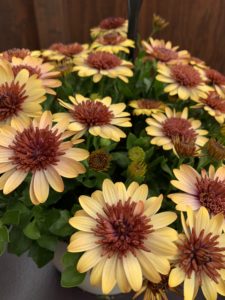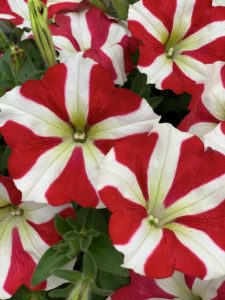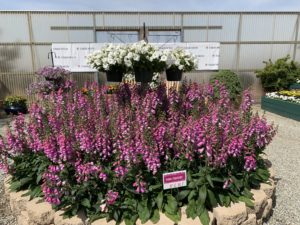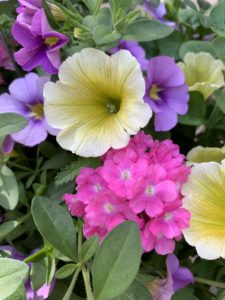The annual California Spring Trials (CAST) happens each spring, when plant and seed buyers visit several sites up and down the Pacific coast. Each year, Welby Gardens sends a team, and the 2019 group consisted of five members including Welby Gardens Program Manager Mandy Gerace. Plus, they were joined by Dr. James Klett from Colorado State University.

“CAST gives us the opportunity to preview new varieties to add to our program and to connect with our suppliers. We also trial many of the new varieties throughout the year and for our grower trial event in August. We will have most of these items in Welby’s August trials,” said Gerace. “I haven’t found statistics on how many people attend, but several hundred people visit each site each day. It is more than 10,000 people who come from all over North America.”

She and her colleagues flew to Santa Barbara and started in Santa Paula, visiting Ball Horticulture and GreenFuse Botanicals. They worked their way up the coast and ended in the Salinas Valley in Gilroy, visiting Danziger and Syngenta Flowers.
“We typically put about 800 miles on the rental vehicles within five days,” Gerace explained. “We not only fill our days with visiting all the trial sites, which include visiting our vendors. We meet breeders who are an interesting group of people, and they sometimes show us what they are working on that is several years from public release. It’s fun to be able to really talk to them, and get to know all these people on a personal level.”
In addition to the nurseries and farms, each site features very inspiring displays. The hosts don’t hold back, so displays can be pretty extravagant and spectacular, she added.
Here are several new and trending plants that really stood out to her and Klett.
1. Downy Mildew-Resistant Impatients

A really exciting development for the green industry is downy mildew-resistant impatiens. At Ball Horticulture, PanAmerican Seed introduced their Beacon series and Syngenta introduced the Imara,® XDR series. Both are going to be really important since downy mildew has been devastating to retailers, wholesalers and landscapers. The mildew has been an issue throughout the the world. Though replacements include New Guinea impatiens and begonias, none of them can match the original impatiens in terms of color range and powerful seeds.
Breeders say these new varieties with genetic modification help fight off the mildew and overpower it. This year, CSU is doing a trial in its shade garden with both Beacon and Imara, and comparing them to some of the older varieties to confirm that they are mildew resistant.
“Some more of our favorite lines of resistant impatiens are the SunPatiens® for their vigor and beauty, which have really taken off in the last couple years, and include varieties such as ‘Tropical Orange,’” said Gerace. “There’s definitely more coming down the line. The nice part is that if you have sunny and shady areas, these impatiens can take either condition.”
Another exciting impatiens is New Guinea impatiens ‘Roller Coaster Hot Pink’ from Dümmen Orange. This variety stands out for the beautiful ruffles on its flowers.

2. Begonias & Daisies

Another trend that he saw is more begonia varieties, including those that are ever blooming and seem to do well in both sun and shade. Benary has had outstanding begonias for a couple years, but they have done even more breeding recently. Klett thinks more and more of their plants will be used in Colorado landscapes. The BIG® series including BIG® Red Bronze Leaf is expected to do very well.
GreenFuse has the new Begonia Rex Bewitched Series, which is all very interesting. Gerace described the Rex foliage as what people like about them, “The leaves are big and intricate. They look like dinosaur skin, or what we would imagine dinosaur skin to look like in texture and shade, so they are named after a T-Rex. It’s an interesting new variety that we can trial out here in Colorado and see how they do.”
Gerace sees a great future for the Osteospermum 4D Harvest Moon, an introduction in the 4D series from Selecta. While traditional osteopermum (African daisies) close at night, hiding the attractive petals with eyes at the center, the 4D series doesn’t close and has tiny petals in the center. Harvest Moon has an orange, coppery center and is a little bit lighter on the outside.
“Some people don’t like the osteospermum because the flowers close at night and so are not as interesting when the sun is going down or in the early morning. The 4D series makes them kinda cool, kinda fun,” she said.
Another notable daisy is the Leucanthemum Betsy from GreenFuse, which is a Shasta daisy with a really big flower and nice habit.
3. Petunias & Dahlias

The Welby team is super excited about some of the petunias like those from Danziger. The Amore series, that has a heart-shaped pattern on each flower, has been broadened. Now, the series includes the red and white Amore King of Hearts and Amore Pink with hot pink and white flowers.
“Amore really seems to perform well. We are excited to get some of these varieties in our trials to see how they do in Colorado,” she said. “From Dümmen Orange, we really like Durabloom Royal Pink. It’s really tough, sturdy and strong with nice big flowers with nice dark veins.”
Klett pointed out that companies seem to be competing more for the petunia market, to challenge Proven Winners dominance there. In particular, that grower’s Supertunia Vista® Bubblegum petunias have been very popular.
Another trend he noticed at the trials was more varieties of dahlia. Some are dwarfs and can be used in small spaces, while others are very tall with many flowers, providing large heights and cuttings from just one plant.
“Syngenta has one called Dahlia Sincerity that I was totally impressed and blown away with in California. We got some for our trials this year. I’m anxious to see how they will perform,” he said.
4. Senatti®, Digitalis, Lantana, & Lobelia
 Other memorable plants from this spring’s trials include Pericallis Senetti® White from Suntory. Gerace was impressed with its nice, clean white color, and thinks it will be a good cool weather plant for early spring as well as an attention-grabbing indoor pot plant. Digitalis ‘Pink Panther’ from Takii is also really pretty.
Other memorable plants from this spring’s trials include Pericallis Senetti® White from Suntory. Gerace was impressed with its nice, clean white color, and thinks it will be a good cool weather plant for early spring as well as an attention-grabbing indoor pot plant. Digitalis ‘Pink Panther’ from Takii is also really pretty.
The large number of lantanas was apparent. Klett noticed a trend away from the mixed colors to new single colors like solid yellow or red that are exciting.
“Another thing I see happening is with the annual called lobelia. Past breeding has produced plants that decline in the midsummer heat of Colorado, so now they’ve been breeding more heat-tolerant plants that will still look good in September, which is very unusual for lobelia,” he said.
5. Combinations & House Plants

In more general trends, Klett and Gerace noticed more combinations and house plants. Some very interesting plant combinations are making it easier to create hanging baskets and containers.
“We used to get three colors of one genus in a plug, but now we’re getting three different genera in one plug,” the professor explained. “They end up looking pretty uniform in a hanging basket or container. It’s an interesting trend.”
Gerace added that trends like those and the promotion of house plants are exciting, because they get more young people excited and involved in horticulture. “They want plants in the house, and growing things around them, and I think that’s really important for our industry,” she concluded.
2020 Plant Ideas from CSU Trials
By Dr. James Klett, Professor & Extension Horticulturist, Colorado State University
In more general trends, Klett and Gerace noticed more combinations and house plants. Some very interesting plant combinations are making it easier to create hanging baskets and containers.
“We used to get three colors of one genus in a plug, but now we’re getting three different genera in one plug,” the professor explained. “They end up looking pretty uniform in a hanging basket or container. It’s an interesting trend.”
Gerace added that trends like those and the promotion of house plants are exciting, because they get more young people excited and involved in horticulture. “They want plants in the house, and growing things around the Each year, Colorado State University receives about 120 or so new perennials that have been introduced in the last three years. We do a three-year perennial trial where we keep each plant for three springs and the two winters in between. Here are some trends with perennials in our trials for their first year in 2019.
One interesting trend is hybridization between some of the more common perennials. We’re seeing more hybrids like between rudbeckia and echinacea. We have them in our trials this year, and their supposed to be a little more heat tolerant and work better in containers. The Summerina® series is a good example of this.
Another trend is more breeding of dwarf perennials. Salvias, for instance, used to grow to 18 and 24 inches or even taller. New varieties are now topping out at 12 inches, for use in containers and smaller landscapes. Instead of just using annuals in containers, the trend is towards using more perennials in containers. Danzinger has come up with a whole dwarf series for this purpose. We have 12 plants from Dutch Heritage in this year’s trials, and they have a lot of perennials that can grow in mixes in containers.
This year, a mini climber rose called ‘Cherry Frost’ was introduced by Star Roses. It features small clusters of blooms, is self-supporting, and grows to only 6 feet at the most, so could be used in smaller landscapes.
A third trend is the use of more colored foliage in perennials. Even some of the Russian sages are getting both dwarfer and more colorful with a yellower chartreuse foliage. We’ve seen the colorful foliage on coral bells for years, but now we are seeing it more with other traditional perennials.
It amazes me to see how breeders keep expanding the plant palette. It’s always interesting to see what happens, and we will see how they perform for the Rocky Mountain region and Colorado in the trials at CSU, Welby Gardens and other sites this summer, and I think that’s really important for our industry,” she concluded.











